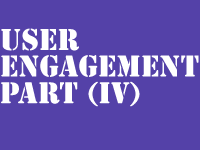
Retention: great experience = loyal users
24 July 2009, Rupert Hughes
 Your site’s user experience (UX) is working to create loyalty from the moment a user lands on your site, but in the Retention phase, it’s not just your site’s UX that matters.
Your site’s user experience (UX) is working to create loyalty from the moment a user lands on your site, but in the Retention phase, it’s not just your site’s UX that matters.
Now you’ve converted your carefully acquired and cleverly engaged customers, the final step in the customer life cycle is to hang onto them. User loyalty is not only a vindication of a great customer experience, it’s also vital to a successful business because, as Frederick Reichheld (author of The Loyalty Effect: The Hidden Force Behind Growth, Profits and Lasting Value) established in the mid 90s, the cost of acquiring new customers is around five times that of servicing existing ones.
Registration & Personalisation
Your site’s user experience (UX) begins influencing your user’s loyalty from the moment they reach the site. Not just because a better experience makes them more likely to return, but also through direct retention factors such as how easy your registration process is and whether the reasons to register and opt-in to further communication are compelling and clear enough.
If you’re doing ecommerce where registration is a necessary part of the purchasing journey, then this is simple enough (but keep in mind good Conversion UX). If registration is less integral to your site experience, then make the “Register” link easy to find. Studies show that users search the edges of a web page for subscribe/register information, so place it there and put it in a global navigation element so that it’s available from every page. Then seed your content with reasons why the user might want to register.
Good form design is essential and since you’re going to need an email address and a unique username, why not make the email address the username? That makes one less field for the user to fill in, is already a unique value and pretty much guarantees a username they will remember rather than names of the “dave-y24530” variety that many sites offer as less-than-helpful suggestion.
Once someone’s registered, personalise their experience on your site:
- If you have their name, use it!
- Offer users information that’s relevant to what you know about them and encourage them to provide you with more. They will if you can demonstrate the value to them.
- Use cookies to store some of their personal information (name, location, what they looked at on their last visit, etc.), so they don’t have to sign in every time. But, make sure you require a log in before they can access any private or secure details.
Offline Customer Experience
In the Retention phase, your off-line customer experience has a big part to play too. A study in the 90s found that 96% of customers who received their web order on time said they were “likely” or “very likely” to use that site again (See Jakob Nielsen on Loyalty on the Web for more details). That principle is still true today: if you can’t carry great site UX through to your off-line processes, then you won’t hang on to your customers.
Assuming though that your on and off-line UX is great, then there’s a rapidly increasing number of methods for encouraging return visits to your site from “social media” sites such as Facebook or, Twitter. You have less control of the UX here as you’re operating in someone else’s environment, so the key to maintaining a consistent experience will be in the quality of your copy (quite a challenge in Twitter!) and information scent.
Email marketing
For many site owners the key retention method is likely to be email marketing. This presents some big challenges for good user experience since the medium is naturally more intrusive than a website. You therefore need to make sure you have a valuable message, so your mail is not immediately deleted or unsubscribed from. You’re also competing with all the other marketing messages users get every day, so you need to stand out. Here are a few tips:
- Stick to the frequency agreed when users signed up. If it’s a monthly newsletter, don’t send it more often.
- Make sure you have something worth saying. Users will quickly stop opening emails that are just an excuse for the marketing department to flex their copywriting skills.
- Try to send it at the same time, every time, so your users fit it into their schedule. If it’s a daily business bulletin, make sure it’s arriving in inboxes around 9 am on business days.
- Write a great subject line. Think of it like a headline in a newspaper. It’s the most important piece of content because a good one makes your mail more likely to be opened. Keep it to no more than 60 characters to ensure it displays in most email clients.
- Test, test, test. Email clients all differ in the way they render HTML and most are considerably less sophisticated than web browsers. So make sure your mail displays properly (or at least degrades gracefully) in the popular email programs (e.g. Outlook, Eudora, Hotmail, Gmail, Yahoo! Mail, etc.). Particularly check that it works if images are switched off as many email clients block these by default nowadays.
- When writing your email content, follow the same principles of scannability and information scent that you would for a web page.
- Make sure you add some trackable parameters to the links from your email so that you can see which ones are generating traffic and how much.
Retaining customers ultimately makes for a successful business and, if you’ve read all four posts in this series you’ll have seen how getting your UX right at each stage of the customer life cycle will help you achieve that goal. So, don’t just leave UX in the hands of your web designers. To be really successful, great UX should apply through every touchpoint that a customer has with an organisation and that only really works when everyone within that organisation has the customer in mind in everything that they do.
This article was written by Rupert Hughes of Firehorse Digital


